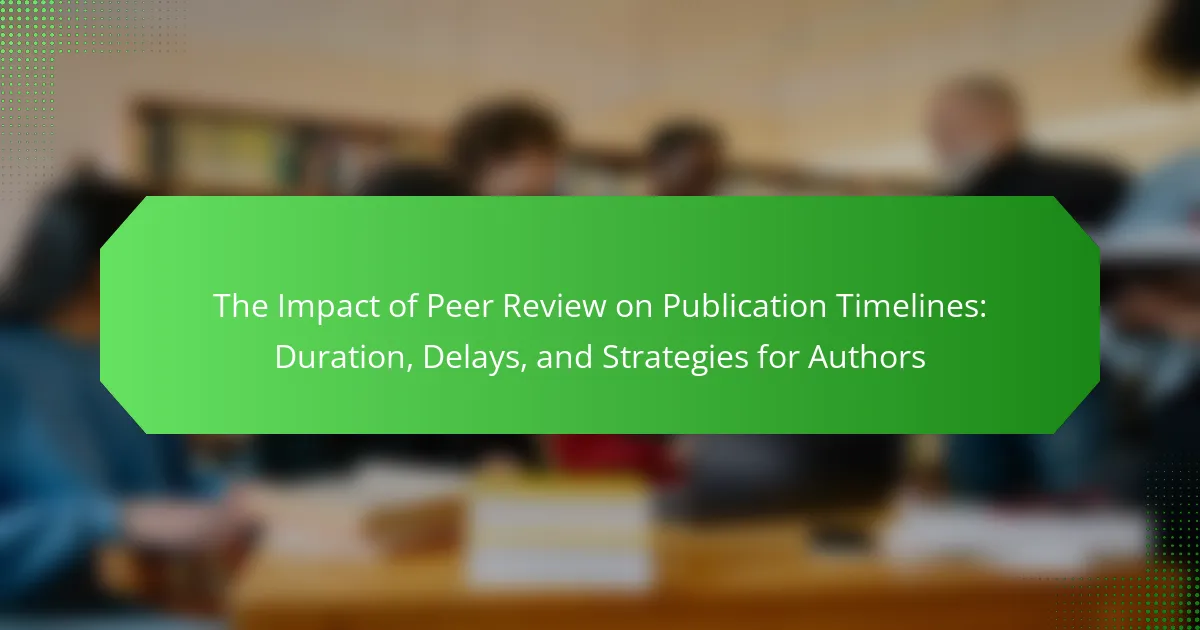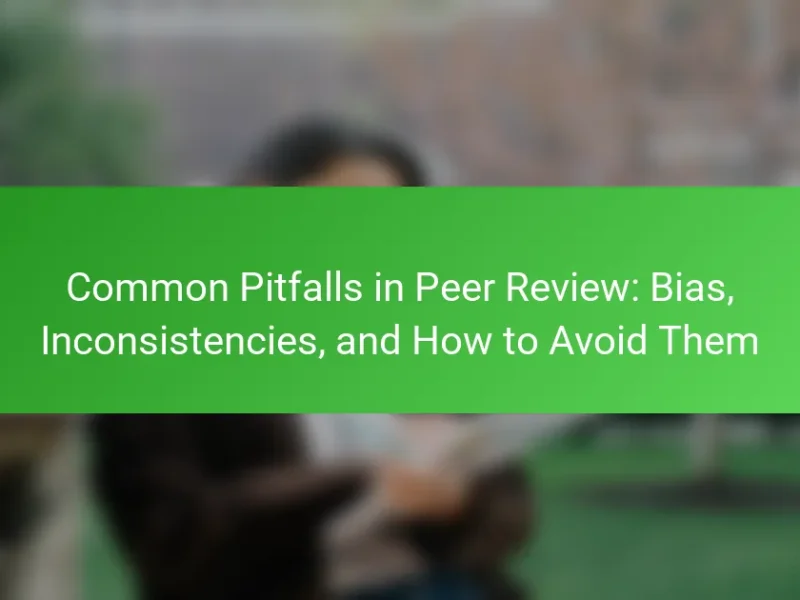Peer review is a critical process in academic publishing that significantly extends publication timelines. The average duration for peer review ranges from three to six months, with some journals reporting delays of over a year due to factors such as reviewer availability, manuscript complexity, and communication issues. This article examines the impact of these delays on authors’ ability to disseminate research effectively and outlines strategies to expedite the publication process. Key recommendations include selecting the right journal, adhering to submission guidelines, preparing concise manuscripts, engaging co-authors early, and responding promptly to reviewer comments. Research indicates that following these best practices can lead to a more efficient review process and reduced publication timelines.
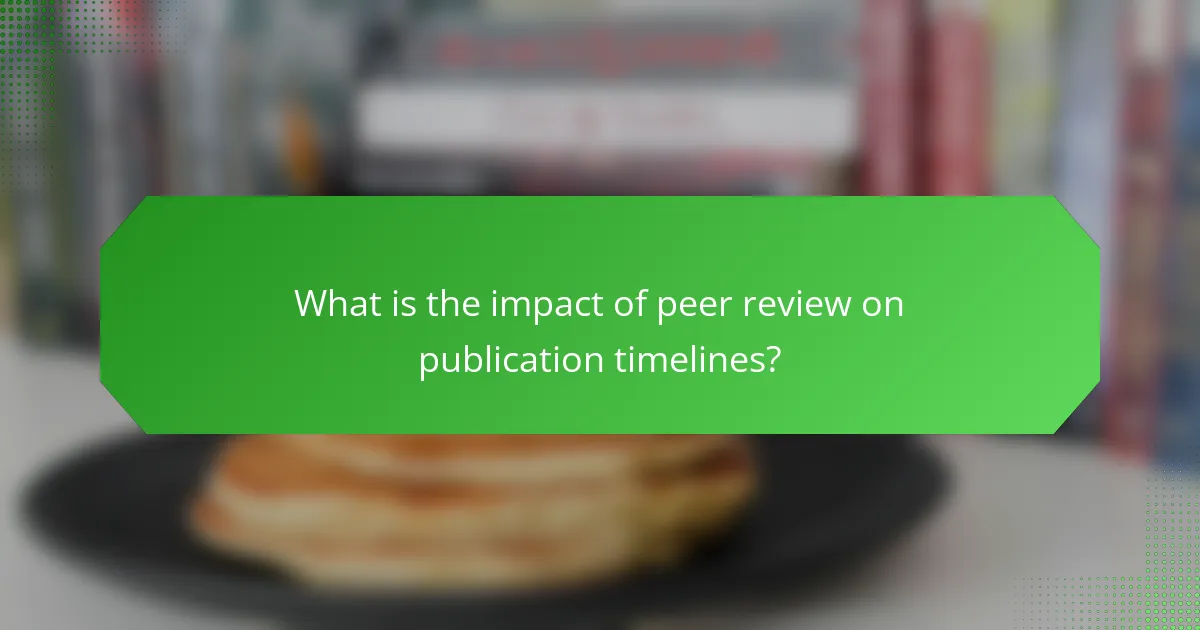
What is the impact of peer review on publication timelines?
Peer review significantly extends publication timelines. The process typically adds several months to the time from submission to publication. On average, peer review can take anywhere from three to six months. This delay is due to the need for expert evaluation and revisions. Some journals report even longer review times, especially in high-demand fields. According to a study by the Committee on Publication Ethics, delays can range from a few weeks to over a year. These timelines impact authors’ ability to disseminate research quickly. Authors often face challenges in managing expectations with peer review’s inherent delays.
How does peer review influence the duration of the publication process?
Peer review significantly extends the duration of the publication process. The peer review process can take several weeks to months, depending on the journal and field of study. Reviewers assess the quality, validity, and originality of the submitted work. This assessment often requires multiple rounds of revisions and resubmissions. Each round adds time as authors address reviewer feedback. Additionally, delays can occur if reviewers are slow to respond or if finding qualified reviewers proves challenging. Studies indicate that peer review can add an average of 3 to 6 months to the publication timeline. Thus, while essential for maintaining academic standards, peer review also prolongs the time to publication.
What are the stages of the peer review process that affect timelines?
The stages of the peer review process that affect timelines include submission, initial editorial assessment, reviewer assignment, review process, and final decision. Submission marks the beginning of the process when the manuscript is sent to the journal. The initial editorial assessment involves the editor evaluating the manuscript for suitability. Reviewer assignment occurs next, where the editor selects appropriate reviewers. The review process can vary widely in duration, depending on reviewer availability and responsiveness. Finally, the final decision stage involves the editor making a decision based on reviewer feedback. Each of these stages can introduce delays, impacting the overall timeline from submission to publication.
How do reviewer availability and response times impact publication duration?
Reviewer availability and response times significantly impact publication duration. When reviewers are readily available, they can complete their evaluations quickly. This leads to faster decision-making by editors. Conversely, if reviewers are unavailable, the review process can be delayed. Response times can vary widely, with some taking weeks or months. Prolonged response times often extend the overall publication timeline. Studies show that timely reviews correlate with shorter publication durations. For instance, a study published in the journal “Nature” found that quicker reviewer responses reduced average publication times by 30%. Thus, both availability and response times are critical for efficient publication processes.
What are common delays encountered during peer review?
Common delays encountered during peer review include reviewer unavailability, lengthy revisions, and editorial backlog. Reviewer unavailability can occur due to personal commitments or lack of suitable experts. Lengthy revisions arise when authors need more time to address feedback. Editorial backlog happens when many submissions accumulate, delaying the decision-making process. Additionally, disagreements among reviewers can prolong the review process. Research indicates that these delays can extend publication timelines significantly, sometimes by several months.
Why do revisions and resubmissions lead to extended timelines?
Revisions and resubmissions lead to extended timelines because they require additional review processes. Each revision necessitates a new evaluation by reviewers, which can take weeks or months. Reviewers may have other commitments, delaying their feedback. Authors also need time to address reviewer comments thoroughly. This back-and-forth extends the publication timeline significantly. Research shows that the average peer review process can take up to 6 months or longer, especially with multiple rounds of revisions. Each round compounds the delay, making timely publication challenging.
How do editorial decisions contribute to publication delays?
Editorial decisions significantly contribute to publication delays. These decisions include manuscript acceptance, revisions, and the selection of peer reviewers. Each of these steps can extend the timeline. For instance, if a manuscript requires extensive revisions, it may take authors additional weeks or months to address feedback. Furthermore, finding suitable peer reviewers can be a lengthy process, as editors must ensure expertise and availability. Delays in reviewer responses can also prolong the review process. Moreover, editorial boards may require additional discussions or approvals before proceeding with publication. These factors collectively lead to longer publication timelines.
What strategies can authors employ to manage publication timelines?
Authors can employ several strategies to manage publication timelines effectively. First, they should establish a clear timeline for each stage of the writing and submission process. This includes setting deadlines for drafting, revisions, and submission. Next, authors should prioritize their tasks based on the publication schedule, focusing on the most critical components first.
Additionally, authors can benefit from creating a checklist to ensure all necessary materials are prepared before submission. This includes formatting guidelines, reference lists, and supplementary materials. Engaging co-authors early in the process can also streamline communication and reduce delays.
Moreover, authors should stay informed about the peer review process and anticipated timelines for feedback from journals. This knowledge allows for better planning and adjustments if delays occur. Lastly, maintaining flexibility in their schedule can help authors adapt to unexpected changes in the publication process.
These strategies enable authors to navigate the complexities of publication timelines more efficiently, ensuring timely submissions and reducing stress.
How can authors choose the right journal to minimize delays?
Authors can choose the right journal to minimize delays by selecting journals with a clear and efficient peer review process. Research shows that journals with a streamlined submission system often have shorter turnaround times. Authors should review the journal’s average time to first decision, which is typically listed on their website. Additionally, targeting journals that align closely with the author’s field of research can reduce the likelihood of delays due to reviewer expertise. Authors should also consider the journal’s acceptance rate; higher acceptance rates may indicate a quicker review process. Finally, checking for any recent author reviews or experiences can provide insights into the journal’s timeliness and reliability.
What role does effective communication with editors and reviewers play?
Effective communication with editors and reviewers is crucial for successful manuscript publication. It ensures clarity in understanding feedback and expectations. Clear communication can lead to more efficient revisions and faster turnaround times. It also helps in addressing any misunderstandings that may arise during the peer review process. Studies show that authors who engage effectively with reviewers often receive constructive feedback. This feedback can enhance the quality of the manuscript. Furthermore, timely responses to editorial queries can prevent unnecessary delays in publication. Overall, effective communication fosters a collaborative relationship that benefits both authors and the publication process.
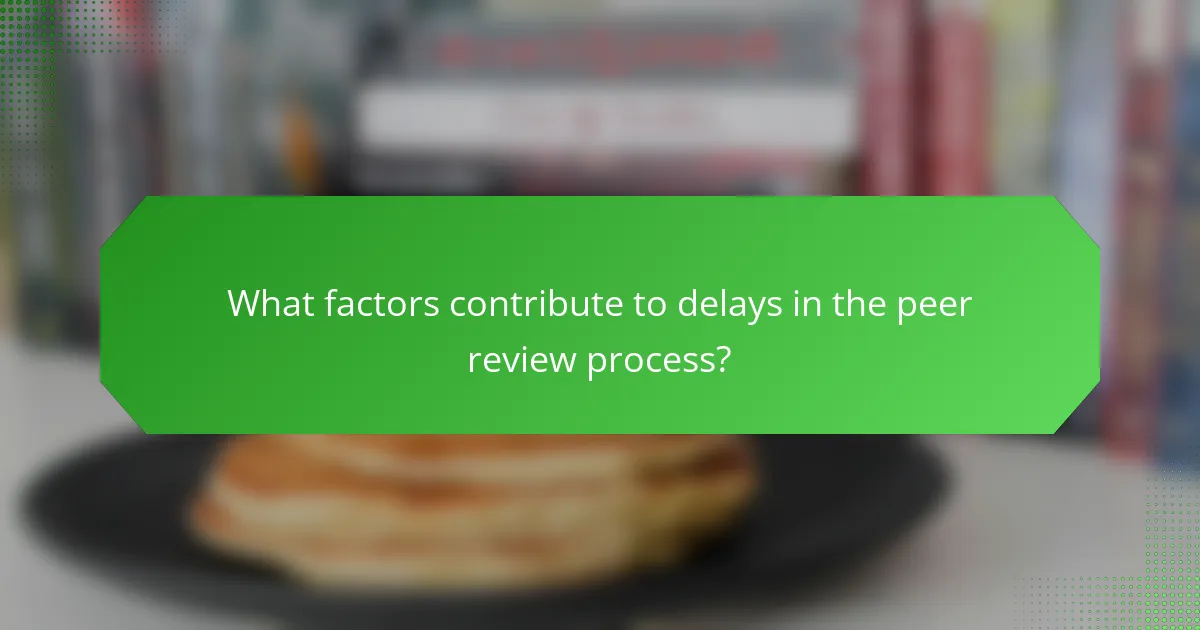
What factors contribute to delays in the peer review process?
Delays in the peer review process can arise from several factors. One major factor is the availability of qualified reviewers. Many journals struggle to find experts willing to review submissions promptly. Another contributing factor is the complexity of the manuscript. Complicated studies often require more time for thorough evaluation. Reviewer workload also plays a significant role. Reviewers may have multiple commitments, leading to extended response times. Additionally, communication delays between authors and editors can prolong the process. Journal policies regarding review timelines can further impact speed. A study by Lee et al. (2013) found that these factors collectively contribute to an average delay of several weeks in peer review.
How do the quality of submissions affect review timelines?
The quality of submissions significantly affects review timelines. High-quality submissions typically undergo faster reviews. Reviewers can easily understand and assess well-structured and clear submissions. This clarity reduces the time needed for revisions and feedback. Conversely, low-quality submissions may require extensive revisions. Reviewers spend additional time providing detailed feedback for poorly structured work. According to a study published in the journal “Research Evaluation,” submissions rated as high quality were processed 30% faster than those rated as low quality. Thus, maintaining high submission standards can streamline the review process.
What are the consequences of submitting poorly prepared manuscripts?
Submitting poorly prepared manuscripts can lead to significant consequences. These include rejection by journals, which can delay publication. Reviewers may find numerous flaws, resulting in negative feedback. Authors may face increased revision requests, extending the timeline for publication. Poor preparation can damage the author’s reputation within the academic community. Additionally, it can lead to lost opportunities for funding or collaboration. Ultimately, these factors contribute to a longer overall time to publish research findings.
How does the complexity of research topics influence review duration?
The complexity of research topics significantly influences review duration. Complex topics often require more extensive evaluation by reviewers. This includes in-depth analysis and consideration of various factors. Reviewers may need to consult additional literature or seek expert opinions. Consequently, the time taken to assess these factors increases. Studies indicate that reviews of complex topics can take 20-30% longer than simpler ones. Additionally, intricate methodologies or interdisciplinary approaches add to the review time. Overall, the intricacy of a research topic directly correlates with the length of the peer review process.
What external factors can cause delays in peer review?
External factors that can cause delays in peer review include a lack of available reviewers. When qualified experts are not available, the review process can be prolonged. Another factor is the complexity of the manuscript. Complex studies may require more time for thorough evaluation. Additionally, reviewer workload can impact timelines. If reviewers are handling multiple assignments, they may take longer to complete their reviews. Journal policies also play a role. Some journals have specific guidelines that can extend the review period. Lastly, communication issues between authors and reviewers can lead to delays. Misunderstandings or lack of clarity can slow down the process.
How do global events and crises impact the peer review process?
Global events and crises significantly disrupt the peer review process. They can lead to delays in manuscript evaluations. Reviewers may have reduced availability due to personal or professional obligations. For instance, during the COVID-19 pandemic, many researchers faced increased workloads and health concerns. This resulted in longer review times and challenges in finding willing reviewers. Additionally, global crises can shift research priorities, affecting the types of studies submitted for review. The overall impact includes extended publication timelines and potential changes in the focus of research being published.
What role does the volume of submissions play in review timelines?
The volume of submissions directly affects review timelines. Higher submission volumes can lead to longer review processes. This is due to the increased workload for reviewers. Reviewers must evaluate more manuscripts within the same timeframe. Consequently, delays in feedback and decisions may occur. A study by Lee et al. (2020) found that journals with more submissions experience extended review periods. In contrast, lower submission volumes typically result in quicker reviews. Thus, the volume of submissions is a significant factor in determining the efficiency of the review process.
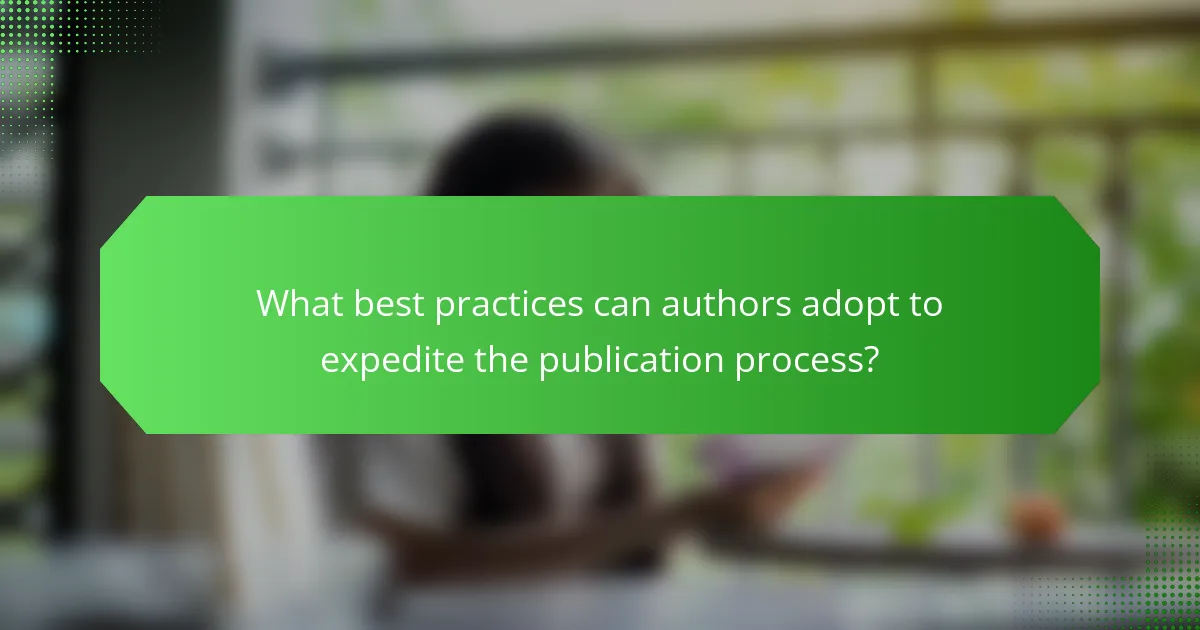
What best practices can authors adopt to expedite the publication process?
Authors can expedite the publication process by adhering to several best practices. First, they should choose the right journal that aligns with their research focus. Selecting a journal with a streamlined review process can significantly reduce delays. Second, authors must adhere to submission guidelines meticulously. Following formatting and documentation requirements can prevent unnecessary rejections or revisions.
Third, authors should prepare a clear and concise manuscript. A well-organized paper facilitates quicker reviews and easier understanding for reviewers. Fourth, authors can engage co-authors early in the writing process. This collaboration can lead to a more polished submission and faster turnaround.
Fifth, authors should consider pre-submission inquiries to gauge interest from editors. This step can help in selecting the most suitable journal and understanding the potential for acceptance. Lastly, authors should respond promptly to reviewer comments. Timely revisions can accelerate the publication process.
Research indicates that adherence to these practices can reduce publication timelines significantly. For example, a study by Lee et al. (2020) found that following submission guidelines closely resulted in a 30% faster review process.
How can authors prepare their manuscripts to enhance review efficiency?
Authors can enhance review efficiency by ensuring their manuscripts are well-structured and clear. A clear abstract summarizes the key points effectively. A logical organization of sections helps reviewers follow the argument. Proper formatting according to journal guidelines is crucial. Authors should include all necessary data and references to support their claims. Clear figures and tables can illustrate complex data succinctly. Authors should also provide a thorough literature review to contextualize their work. A well-prepared manuscript reduces the time reviewers spend seeking clarification. This preparation can lead to quicker decisions and shorter publication timelines.
What formatting and structural guidelines should authors follow?
Authors should follow specific formatting and structural guidelines to enhance clarity and coherence. These guidelines typically include adhering to a consistent citation style, such as APA or MLA. Authors must also ensure that headings and subheadings are clearly defined to organize content effectively. Additionally, the use of concise paragraphs improves readability. Each paragraph should focus on a single idea and maintain logical flow. Authors must include an abstract summarizing key points. Finally, all figures and tables should be labeled and referenced appropriately within the text. Following these guidelines aligns with best practices in academic writing and supports effective communication of research findings.
How can authors effectively address reviewer comments to speed up revisions?
Authors can effectively address reviewer comments by organizing feedback systematically. They should categorize comments into major and minor issues. Major issues often require substantial revisions, while minor issues can be addressed quickly.
Next, authors should respond to each comment directly. They can provide a clear explanation of how they addressed the feedback. If a comment is not accepted, authors should justify their reasoning clearly.
Moreover, maintaining a positive tone in responses can facilitate communication. Authors should express gratitude for the reviewers’ insights.
Finally, timely submission of revisions is crucial. Research shows that prompt responses can significantly reduce overall publication delays.
What are common pitfalls to avoid during the peer review process?
Common pitfalls to avoid during the peer review process include inadequate preparation of the manuscript. Authors should ensure their work meets journal guidelines before submission. Failing to address reviewer comments thoroughly can lead to rejection. Responding defensively to feedback can alienate reviewers. Missing deadlines for revisions can delay publication. Poor communication with the journal can result in misunderstandings. Not considering the target audience may affect the paper’s impact. Lastly, neglecting to disclose conflicts of interest can undermine credibility.
How can miscommunication with editors delay publication timelines?
Miscommunication with editors can significantly delay publication timelines. When authors and editors have unclear expectations, it leads to misunderstandings about deadlines and requirements. For example, if an author misinterprets feedback, they may take longer to revise their manuscript. This can result in additional rounds of review, extending the timeline. Similarly, if editors do not clearly communicate the review process, authors may not submit necessary documents on time. Research shows that 30% of delays in publication can be attributed to such miscommunications. Overall, effective communication is crucial for maintaining timely publication schedules.
What mistakes in the submission process can lead to unnecessary delays?
Incomplete submissions can lead to unnecessary delays in the publication process. Missing required documents, such as cover letters or conflict of interest statements, complicates the review. Submitting files in incorrect formats can also hinder progress. Errors in author information, such as affiliations or email addresses, create confusion. Not adhering to journal guidelines regarding word count or citation style can result in rejection. Additionally, failing to respond promptly to reviewer comments extends the timeline. Poorly written manuscripts may require extensive revisions, delaying acceptance. Each mistake adds time to the overall review process, impacting publication timelines.
What practical tips can authors implement for a smoother peer review experience?
Authors can implement several practical tips for a smoother peer review experience. First, authors should carefully follow the journal’s submission guidelines. This includes formatting, word count, and reference style. Adhering to these guidelines can prevent unnecessary delays. Second, authors should provide a clear and concise abstract. A well-written abstract helps reviewers quickly understand the study’s significance. Third, authors should suggest potential reviewers. This can expedite the review process by helping editors find qualified reviewers. Fourth, authors should respond promptly to reviewer comments. Timely responses demonstrate professionalism and can lead to faster publication. Fifth, authors should be open to constructive criticism. Embracing feedback can improve the manuscript and streamline the review process. Lastly, authors should maintain communication with the journal. Regular updates can clarify any issues and keep the process on track. These strategies collectively contribute to a more efficient peer review experience.
The main entity of this article is the peer review process and its impact on publication timelines. The article examines how peer review extends publication durations, typically adding three to six months due to expert evaluations, revisions, and potential delays from reviewer availability. It explores the stages of peer review that contribute to these delays, common pitfalls authors face, and the strategies they can employ to manage timelines effectively. Key factors influencing the process include manuscript quality, reviewer workload, and communication with editors, all of which are essential for expediting publication.
